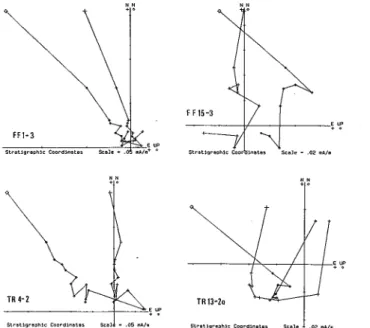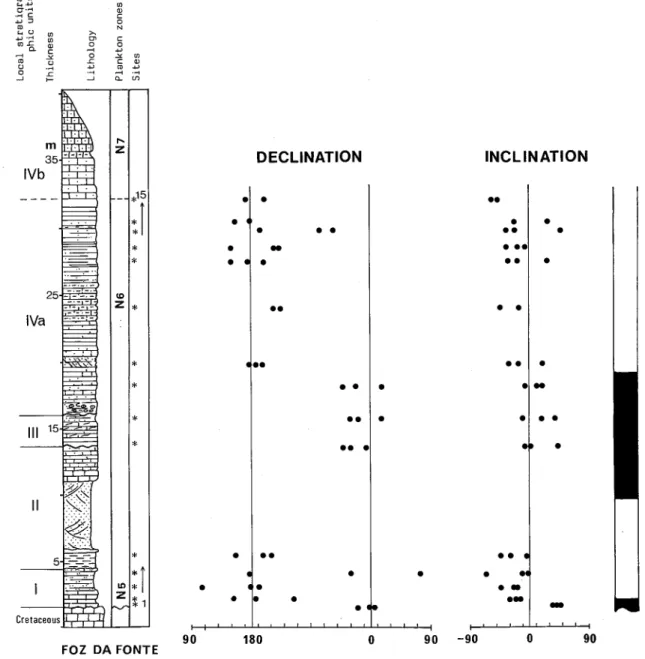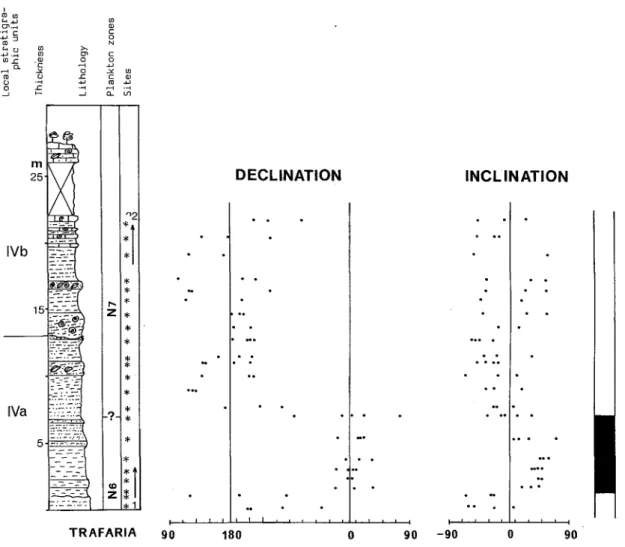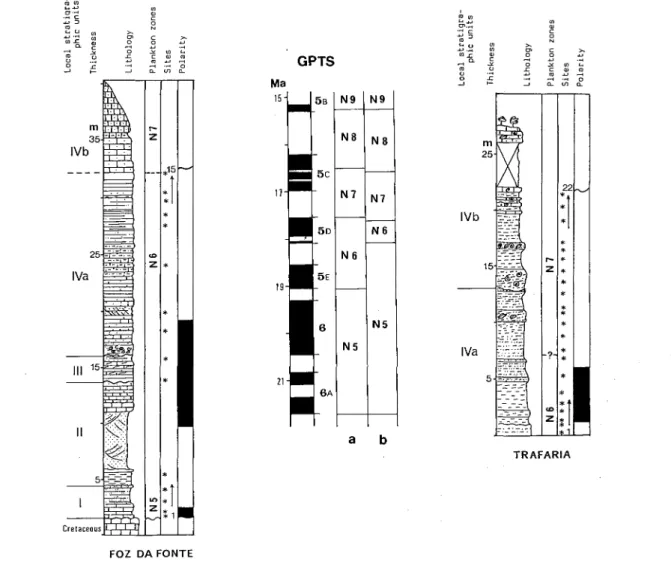Bio and magnetostratigraphy of two Lower Miocene
sections, Tagus basin (Portugal)
S. SEN
*
M. T. ANTUNES**
J. PAIS
**
P. LEGOINHA**.. - Laboratoire de Paleontologie des Vertcbres, Univ. Pierre et Marie Curie. 4. PI. Jussieu, F-75252 Paris cedex 05. France .... - Centro de Estratigrafia e Paleobiologia da U.N.L., Faculdade de Ciencias e'Tecnologia,
Quinta da Torre, P-2825 Monte de Caparica, Portugal
RESUMO
Palavras -chave: Miocenico inferior- magnetostratigrafia -Foraminiferos-Lisboa-Bacia do Tejo- Portugal. Apresentam-se os resultados do estudo da magnetostratigrafia de dois cortes no Miocenico inferior da bacia do Tejo. Foi utilizada a desmagnetizacao termica para isolar a componente primaria de magnetizacao de 45 amostras recolhidas no corte de Foz da Fonte e 74 no de Trafaria. A sucessao de zonas de polaridade magnetica reconhecidas foi correlacionada com a "geomagnetic po-larity time scale"(GPTS) com base em dados biostratigraficos fornecidos pelos foraminiferos planct6nicos.
As zonas de foraminiferos planct6nicos e as de polaridade rnagnetica reconhecidas nestes cortes podem ser correlacionadas adequadamente com a parte da GPTS [tabela calibrada por BERGGREN et al, (1985)] correspondente as anomalias 6 e 5E (Foz da Fonte) e 5D (Trafaria). Estas correlacoes sugerem idades entre 19,35 a 18,14 MaparaocortedeFozdaFonteede 17,9a 16,98Ma para0 de Trafaria.
RESUME
Mots-cles: Miocene
inferieur-Magnetostratigraphie-Foraminiferes - Lisboa - Bassin du Tage - Portugal.
On presente les res ul tats de I' etude magnetostratigraphique de deux coupes concernant Ie Miocene inferieur du bassin du Tage. La desaimantation thermiquea ete employee pour isolerla composante primaire d'aimantation chez 45 echantillons preleves dans la coupe
de Foz da Fonte et chez 74 en provenance de la coupe de Trafaria. La succession des zones de polarite magnetique reconnues a ete correlee avec la "Geomagnetic polarity time scale" (GPTS) en tenant compte des donnees biostratigraphiques fournies par I'etude des forarniniferes planctoniques.
Les zones de foraminiferes planctoniques et celles de polarite magnetique reconnues dans les coupes en question peuvent etre correlees d'une facon satisfaisante avec la partie de la GTPS [tabelle calibree par BERGGREN et al. (1985)] correspondant aux anomalies 6 et 5E (Foz da Fonte) et 5D (Trafaria). Ces correlations suggerent des ages entre 19,35 et 18,14 Ma pourla coupe de Foz da Fonte et de
17,90 a 16,98 Ma pour celle de Trafaria.
ABSTRACT
Key-words: Lower Miocene -
Magnetostratigraphy-Foraminifera - Lisboa - Tagus Basin - Portugal.
The magnetostratigraphy of two sections in early Miocene marine deposits of the Tagus Basin is studied. Thermal demagnetization was used to isolate the primary component of magnetization for 45 samples from the Foz da Fonte section, and for 74 others from Trafaria section. The succession of the polarity zones found in these sections is tentatively correlated with the geomagnetic polarity time scale (GPTS) on the basis of the biostratigraphic data yielded by planktic Foraminifera. The planktic zones and magnetic polarities recognized in these sections can be adequately correlated with the part of the GPTS [table calibrated by BERGpRENet al. (1985)] corresponding to the Anomalies 6 and 5E (Foz da Fonte) and 5D (Trafaria). This correlations suggests ages between 19,35 and 18,14 Ma for Foz da Fonte section, and 17,90 to 16,98 Ma for Trafaria.
INTRODUCTION
The Lower Tagus basin near Lisbon is well known for its Miocene infilling, which comprises a broad variety of lithotypes corresponding to six major transgressive events alternating with regres-sions. Except for the upper Tortonian and the Messinian (which are not so well characterized), stages from the Aquitanian to the Tortonian are represented by lithostratigraphical units that yielded much palaeontological and sedimentological infor-mation in addition to other data.
Furthermore, it must be stressed that the geo-graphic position is specially interesting as this basin offers an unique occasion to establish correlations between the remaining Atlantic basins from western Europe (Aquitaine in France) and the Mediterranean basins, as well as between the North Atlantic conti-nental margins (Europe plus western Africa-North and central America).
Much work has been done in the Tagus basin since the first known geological observations ofT. D'ALMEIDA (1762). The first sections at Fonte da Telha were described by the remarkable mineralo-gist (and later politician, one of those who master-minded Brazil's Independence), Jose Bonifacio de ANDRADA E SIL YA (1817), then occupied in the reactivation ofMediaeval and Arab times gold mines in these region.
Early palaeontologie and geologic work was done by Daniel SHARPE (1834, 1842), WILHELM-LUDWIG, Baron YON ESCHWEGE and Alexandre YANDELLI (both 1831).
Later on, excellent palaeontologie research on mollusks was carried on by F. Pereira da COSTA (1866-1867) during the period of the (2d) Comissao Geologica.
Field work was carried out, mostly by Carlos Ribeiro, who presented a paper on the Tertiary for-mations of Portugal to the International Geological Congress, in Paris (1878).
Characterization oflithostratigraphic units was firstly attempted by SHARPE (1842) who included Miocene beds in a single unit that he named"Almada beds". A detailed study was conducted much later by J. C. Berkeley Cotter, which was best presented as a stratigraphic introduction to the study by Dollfus on miocene mollusks (DOLLFUS, COTTER & GOMES, 1903-1904).The units defined by Cotter ("divisions", as he called them) are still in use, although a thorough revision is needed.
Despite some contributions by P. Choffat, re-search nearly stopped until 1937 with G.Zbyszewski, New investigation was carried on and promoted by M.T.Antunes since 1959, either directly or in collaboration with other researchers.
PALAEOMAGNETIC STUDY Sampling
During a field trip in April 1989, sections were sampled for magnetostratigraphical study. The re-sults concerning two sections, Foz da Fonte and Trafaria, are presented. For the situation of these sections and their geologic and palaeogeographic context see figure 1.
Oriented blocks, with azimuth and dip meas-ured, were collected at 15 horizons in the Foz da Fonte section (thickness 29.7m) and 22 horizonsin
Trafaria (thickness 21.5 m). The continuity of the outcrops allows good stratigraphic control and the determination of vertical distances between sites with an accuracy of 10 em. In the Trafaria section, the sediments are quite homogeneous, consisting ofsilts and silty clays. The Foz da Fonte section presents a more diversified lithology including clays, sandstones and limestones.
Blocks were drilled in the laboratory in orderto obtain 22 mm long cylindrical samples of a standard volume. Compressed air was used to cool the corer
cases, the more coherent values are taken as declina-tions and inclinadeclina-tions, and the polarity was deduced from the magnetic behaviour of samples during the successive steps of demagnetization. At least three samples from each site were demagnetized to deter-mine its polarity with accuracy.
The magnetic behaviour, during demagnetiza-tion, of the sediments from the Foz da Fonte section
is quite variable; this is probably a consequence of the more diversified lithology found in this section. In the two sites, the intensity of magnetization de-creases sharply (more than 50%) below the tempera-ture of 150°C; it is then gradually cleaned up to a temperature of 500°C, showing almost stable direc-tions. In the other sites, the cleaning ofthe remanence is more regular up to temperature of 380°C or450°C.
foz.14-1B MMAX ~ .251 mAim -o 100 200 300 400 500 500 Step 0.0'--~-~-~---~~ 1.0 0.5 foz, 5-3 MMAX ~ .257 mAim -o 100 200 300 400 500 Step o.0l---~_~_~_~_~ 0.5 -1.0 foz,1-2 MMAX = .315 mAim o 100 200 300 400 500 600 Step 1.0 0.5 MMAX = .159 mAim ~
tr.
19-4 :::E -<, :>: o 100 200 300 400 500 Step 1.0 0.5 0.0'---~-~_~_~_~tr.6-4A
o 100 200 300 400 500 600 Step o.0l--~_~_~ ~~ 0.5 - - - -1.0 MMAX = .153 mAimtr.2-1A
o 100 200 300 400 500 600 Step o.0l--~_~_~ ~~Fig. 3 - Decay curves of the intensity of magnetization during the thermal demagnetization for six samples from the Foz da Fonte and Trafaria sections.
As in the Trafaria samples, the remagnetization, along with an increase ofthe magnetic susceptibility, is observed in seven sites up to 380°C and in six others up to 450°C. Therefore, the directions of the primary component are presumably determined af-ter the cleaning of the viscous component and/or the secondary component and prior to the occurrence of
the intensity increase (Fig.4). HI-3
StrllUgrllph:lcCoord:lnlltes
----+'---11----'~~
StrllUgrllph1c CoorlUnlltes Sc"l,,· .02 mAl.. Polarities
Fig. 4 - Zijdcrveld diagrams for four samples from the Foz da Fonte and Trafaria sections.
Declinations and inclinations of the presumed primary component of magnetization are shown in figures 5 and 6 for each sample. Altough we observe some clustering of the declinations around O°C or 180°C, the inclinations are not always as would be expected for the latitude of this region. A large number of samples having southerly declinations show positive or very low negative inclinations. However, for both declinations and inclinations, we can observe some pattern in their gathering in the
TR4-2
---f---=-~u:,
Strllt1grllphlcCoordlnates Sc"l -.05mA/..
N N
specific parts ofthe sections. In all cases, the polarity of each site is inferred not only from the average directions of the presumable primary component, but, more importantly, from the magnetic behaviour
of each sample during demagnetization. Moreover, in both sections, each polarity zone includes several successive horizons because of the regular sampling and the small distances between the horizons.
I '" co ..., co cr""" Q) ",.., c c ...,::J 0 '" c N .... co », +J-..-1 co '" C coL: Q) 0 0 a. c ...; ...., ...; .Y 0 .Y co '" "~ L: C Q) o
:::
ru ..., 0 L: ...; ",.., -' >- -' c, <fl m z"
DECLINATION INCLINATION 35 IVb *15•
•
••
:l
•
•
• •
••
•
•
•
*•
•
•••
*•
•
••
•
ID Z *••
• •
IVa *••
••
•
*• • •
••
*••
•
•
• •
III *•• •
•
II *•
••
••
•
•
•
•
•
••
• •
•
•
•
•
-Cretaceous 90 180 0 90 -90 0 90 FOZ DA FONTEFig. 5 - Declination and inclination of the caracteristic magnetization component in the FozdaFonte section. The left part of the figure concerns stratigraphic data from this section.
From these results, the following sequence of polarities has been observed in the Foz da Fonte section (from the bottom to the top): one normal horizon, four reversed horizons, four more normal horizons and six more reversed horizons. The bound-ary between the first reversed and the second normal zones is approximate because of a gap in the sam-pling (about 8 m) between the sites FF5 and FF6. This part of the section is mainly composed of unconsolidated sands.
In the Trafaria section, three polarity zones are apparent: a normal zone 5 meters thick between two reversed zones. The first reversed zone is
repre-sented by two horizons in the silty clays. At these sites, the weak magnetization of sediments and the presence of a hard secondary component did not allow a primary direction to be clearly determined. Therefore, more samples (five from each horizon) were examined. In most of the samples, the behav-iour of the remanent magnetization during the suc-cessive steps of heating leave no doubt about the reverse polarity of these two horizons. In the other horizons, the directions ofthe characteristic remanent magnetization are reasonably well grouped and al-low the determination ofnormal and reverse polarity zones.
(J) Q) c a N .>, en c a a .-\ ..., a .Y (J) s: C Q) ...., "'..., --I ....;"-1 ...J a.. U1 INCLINATION m 25 "2 IVb
:1
*
*
" *
Z*
*
*
**
*
*
IVa ?*
*
*
*
lC;1
Z *1 TRAFARIA 90 DECLINATION 180 o 90 -90..
....
o
90Fig. 6 - Declination and inclination of the characteristic magnetization component in the Trafaria section. The left part of the figure concerns stratigraphicdatafrom this section.
BIOSTRATIGRAPHY
Both Foz da Fonte and Trafaria sections, al-ready sampled for magnetostratigraphy, were also studied under a biostratigraphic viewpoint, specially as far as planktic Foraminifera are concerned.
Foz da Fonte section
A sample collected 205m from the bottom of this section yielded the first Globigerinoides
altiaperturus. The first appearence of this species is
a datum that has been used as marker for the lower boundary of Globig erinoides altiaperturus
-Catapsydrax dissimilis subzone from the
Globoquadrina dehiscens dehiscens-s--Catapsydrax dissimilis zone (IACCARINO, 1985). The same
datum is also employed to recognize the Aquitanian-Burdigalian boundary (BIZON & BIZON, 1972;
DEMARCQ et al., 1974; BIZON, 1984;
IACCARINO & SALVATORINI, 1982; IACCARINO,1985).
IACCARINO (1985) correlates the
Globigerinoides altiaperturus - Catapsydrax
dissimilis zone with Blow's N5 and N6 zones, No Catapsydrax dissimilis forms have been found at Foz da Fonte. This makes it difficult to correlate the upper part ofthe section to any biozones. The last occurrence of this species is an useful datum to characterize the passage from Globigerinoides
altiaperturus - Catapsydrax dissimilis subzone to Globigerinoides trilobus zone (IACCARINO, 1985),
which corresponds to Blow's N7 zone.
Otherwise Praeorbulina glomerosa s.1. seems entirely absent. This excludes ascribing the Foz da Fonte Foraminifera associations to the Praeorbulina
glomerosa s. 1. zone (IACCARINO, 1985), which may be correlated to Blow's N8 zone.
Summing up, Foz da Fonte section corresponds essentially to BLOW'S N5-N7 zones, evenifits upper levels may be correlated to the lower part of Blow's N7 zone.
Trafaria section
All the samples studied are enriched in
Globigerinoides trilobus and Globigerinoides immaturus. Other species - Globigerinoides
obliquus , Globigerinoides altiaperturus and Globorotalia obesa are common. All samples yield
some forms ascribed toGlobigerinoides bisphericus.
This association allow a rather satisfactory cor-relation ofTrafaria section toGlobigerinoides trilobus
zone (lACCARINO 1985) or to its equivalent N7 zone from BLOW (1969).
Calcareous nannoplankton from Palenca sec-tion (about 6 kilometers East from Trafaria's) al-lowed FONSECA (1977) to ascribe the higher levels from IVa division - corresponding to those of Trafaria section - to MARTINI's NN4 zone. Ac-cording to BERGGREN et al. (1985), this zone
begins at the lower part ofN7 and ends in the midlle part ofN8 zone (Blow); however, the viewpoints of STEININGERet al. (1990) are not identical as to its
upper boundary, which they regard as ending just after the beginning of N8.
Another upper boundary for IV-a unit is given by the mammalian fauna from overlying IV -b unit (Lisboa, Cristo-Rei), characterized by the first ap-pearance ofmastodonts and the lastofanthracotherids
(Brachyodus); this fauna is quite close in age to that
from Artenay, France; that may be ascribed to Mein' s mammal Neogene unit MN4a, which corresponds to the N6 and the main part of N7 Blow's zones (STEININGERet al. 1990), Upper Burdigalian (part)
or to the late Orleanian Faunal unit (also in part), or to the early Aragonian continental stage.
CORRELATION
Based primarily on planktic Foraminifera, some biostratigraphic zones have been identified for both the Foz da Fonte and the Trafaria sections.
According to these data, the first section in-cludes the planktic zones1ying between the top ofN5 and, may be, the base ofN7. In the Trafaria section, N7 zone is well characterized for almost all the section. The central column of figure 7 compares the ranges of the early Miocene planktic zones as pro-posed by BERGGREN et al. (1985) and by
STEININGERet al. (1990), along with their
corre-lations to the geomagnetic polari ty time scale (GPTS)
IVa IVb TRAFARIA a b N9 N9 N8 N8 N7 N7 N6
-N6 -N5 N5 , ro '" ~~ '" "'.~ ID .~c: ~ -:;;~ ~u ~ c-, ~.~ '" '" c c-, GPTS ~"'.ca. .§ID ~0 .3~
'" ~ ro .~ :5 ID ro ~ ;5 ~ '" ~ _ *15:1
11 * * IVa * * * III * II , ~j ~ cr·~c: ID C -:;;~ 2 .:::.~ ~ c-, ~ tn~
c-, ",.c ID~
~ a. c ro .x '" ~ .~ s ID ro o ~ .3 f= ~ 0-'" ~ FOZ DA FONTEFig. 7 - Stratigraphic and magnetostratigraphic data from the Foz da Fonte and Trafaria sections, and the calibration ofthe planktic Foraminifera chronology as proposed by BERGGRENet al.,1985 (a) and STEININGERet al.,1990 (b).
Note the age difference for the N5-N6 boundary.
after BERGGREN et al. (1985). We must emphasize that the major difference between these two calibra-tions concerns the age of the N5 - N6 boundary: 19 Ma according to the first authors, but 18 Ma accord-ing to BERGGREN et al. (1985). In this last calibra-tion, the span of the zone N6 is very brief, e.g. less than 0.5 Ma.
The range of the planktic zones after BERGGREN et al. (1985) implies that the Foz da Fonte section should include the polarity chrons from the top of the Anomaly 6 to the top of the Anomaly 5D. The four polarity zones found in this section are less than the number that would be required by this. Several hypothesis would explain this discrepancy: 1) insufficient sampling to record all polarity zones concerned by the interval of depo-sition; 2) occurrence of some unconformities and/or very low sedimentation rate; 3) the top ofN6 and the N7 zones are not represented. In spite of these difficulties, the only possibility of correlation with the BERGGREN etal. (1985) calibration would be that the complete normal zone found in Foz da Fonte section corresponds to the Anomaly 5E. This corre-lation implies ages between 19.35 and 18.14 Ma for the Foz da Fonte section.
In the STEININGER et al. (1990) correlation table, the planktic zone N6 is very short and it is approximately time equivalent to the Anomaly 5D (fig.?). The polarity zones of the Foz da Fonte section fit worth with this calibration, since in the
BIBLIOGRAPHY
bottom ofthe section, the N5 zone is represented and, otherwise, the N7 zone should berepresented from the middle of the section but this seems not to be
supported by the Foraminifera data.
In the Trafaria section, the palaeontological data allows to correlate the palaeomagnetic anoma-lies with the reverse and upper normal periods ofthe Anomaly 5D and to the lower reverse anomaly of C5C. The correlation is better using BERGGREN et
al. (1985) scale. This correlation implies ages
be-tween 17,90 and 16,98 Ma for the Trafaria section. Taking into account this last correlation, a sedi-mentation rate of 2.1 cm/Ka can be estimated for the two complete polarity zones of the Foz da Fonte section. If we estimate the sedimentation rate by dividing the total thickness of the Foz da Fonte section (29.7m) by the suggested interval of time (19,35-18,14 Ma), this rate willbe2.7cm/ka. In any case, these are quite reasonable amounts often found in such marine deposits (SEN, 1988).
ACKNOWLEDGEMENTS
The present work has been supported by CNRS (France) and INIC (Portugal) grants. S.Sen is grateful to his colleagues from the Laboratoire de Paleornagnetisme de l'IPG (Paris) for discussions and comments. Ms. V.Lee Hagee kindly helped to improve the English. F. Sierro, from Salamanca University, kindly gave some informa-tions about Foraminifera from the Trafaria section.
ALMEIDA, T. d' (1762) - Recreasao Filozofica ou Dialogo Sobre a FilozofiaNatural para instrusao de pesoas curiozas, que nao frequentarao as aulas. Tomo VI e ultimo. Trata dos Ceos e do Mundo. Lisboa, Oficina de Miguel Rodrigues. Tarde XXXV, pp. 400-418.
ANDRADA e SILVA, J. B. (1817) - Memoria sobre a nova mina de ouro da outra banda do Tejo. Lida em 10 de Maio de 1815.Hist.e Mem. da Acad. RiSci Lisboa, T.V. parte I, pp.140-152.
BERGGREN, W. A.; KENT,D. V.& vanCOUVERING,J. A. (1985)- The Neogene: Part 2. Neogene geochronology and chronostratigraphy. In NJ. Snelling (ed.): The Chronology of the Geological record. Geol.SocLondon,
Blackwell Sc.Publ. , Memoir nQ
10, pp. 211-260, 3 fig.
BIZON, G. (1984) - Changes in planktic foraminifera and their environmental meaning. In search of the Paleogene/ Neogene boundary stratotype. Part 2. Potential boundary stratotype sections in Italy and Spain (Gelati,R. & Steininger,F. F.eds.).Riv.lt. Paleont. Strat., 89(4), pp. 557-560, Milano.
BIZON, G & BIZON, J. J. (1972) - Atlas des principaux foraminiferes planctoniques du bassin rnediterraneen. OligoceneIiQuaternaire.Editions Technip , Paris, 316pp.
BLOW, W. H. (1%9) - Late Midlle Eocene to Recent planktonic foraminiferal biostratigraphy. Internat. Conf. Planktonic Microfossils, Ist, Geneva (1967), Proc., vol. I, pp. 199-422, pIs. I-54, text-figs. 1-43.
COSTA, F. P. (1866-1867) - Molluscos fosseis. Gasteropodes dos depositos terciarios de Portugal. Com. Geol.
Portugal, Lisboa, 1Qcaderno (1866), pp. 1-116, 15pl., 2Qcaderno (1867), pp.117-252, l3pl.
DEMARCQ,G.; MAGNE,J.; ANGLADA,R.&CARBONELL, G. (1974)-LeBurdigalienstratotypiquede laVallee du Rhone: sa position biostratigraphique.B.S.G.F., 16(5), pp. 509-515, Paris.
DOLLFUS, G. F.; COTTER, J. C. B.& GOMES; J. P. (1903-1904) - Mollusques tertiaires du Portugal. Planches de Cephalopodes, Gasteropodes et Pelecypodes Iaissees par F.A. Pereira da Costa accompagnees d'une explication sommaire et d'une esquisse geologique.Com.Serv.Geol.Portugal, Lisboa, pp.IX+49+55, 1+28 pl.l tab. ESCHWEGE, W. L., baron Von (1831) - Memoria Geognostica ou Golpe de vista do Perfil das estratificacoes das
differentes rochas, de que he composto0terreno desde a Serra de Cintra na linha de Noroeste a S udoeste ate Lisboa,
atravessando0 Tejo ateIiSerra da Arrabida, e sobre a sua idade relativa.Mem.AcadRiSci.Lisboa, t.XI, parte I,
pp.153-280, pI.II-III.
FONSECA, B. (1977) -Notes sur la geologie et la paleontologic du Miocene de Lisbonne. XVIII- Coupe de Palenca, rive gauchedu Tage: stratigraphie et micropaleontologic (Coccolithophorides),Ciencias da Terra (UNL), Lisboa, nQ
3, pp. 129-141,7 figs., 1pl.
IACCARINO, S. (1985) - Mediterranean Miocene and Pliocene planktic foraminifera. In BOLLI, H., SAUNDERS, J. B,& PERCH NIELSEN,K.,(eds.), Plankton Stratigraphy.Cambridge Univ. Press, pp. 283-314.
IACCARINO, S. &SALV ATORINI, G. (1982) - A framework of planktic foraminiferal biostratigraphy for early Miocene to late Pliocene Mediterranean area.Paleontologia ed Evoluzione, 2, pp. 115-125.
RIBEIRO, C. (1880) - Des formations tertiaires du Portugal.Cong.Int.Geol.de 1878, Paris, nQ21,
pp.205-214. SEN, S. (1988) - Magnetostratigraphie et taux de sedimentation: quelques donnees sur les depots fluviatiles, lacustres
et marins du Neogene rnediterraneen.Bull.Soc.Geol.Fr.,Paris, (8) t.IV, I, pp.161-166, 4 fig.
SHARPE, D. (1834) -On the strata in the immediate neighbourhood of Lisbon andOporto.Proc.Geol.SocLondon, nQ1 (1826-1833), pp.394-3%.
SHARPE, D. (1842) - On the geology of neighbourhood of Lisbon.Trans.Geol.Soc.London, 2th ser., vol.Vl. STEININGER,F.F.; BERNOR,R.L.& FAIll..BUSCH,V. (1990) - European Neogene marine/continental chronologie
correlations. In E. H. Lindsay, V. Fahlbusch and P.Mein (eds.): European Neogene Mammal Chronology.Plenum Press, New York, NATO ASI Series, A, 180, pp.15-46, 1 fig.
V ANDELLI, A. (1830) -Aditamentos ou NotasIimemoria Geognostica, ou Golpe de vista do Perfil das estratificacoes das differentes rochas que compOem os terrenos desde a Serra de Cintra ateIiArrabida.Mem.AcadR.SciLisboa, tXI, parte I, pp.281-306, 2 map., pl.lV-V.



